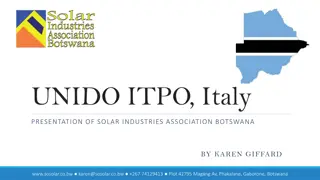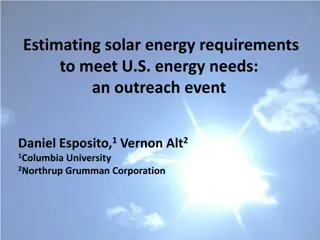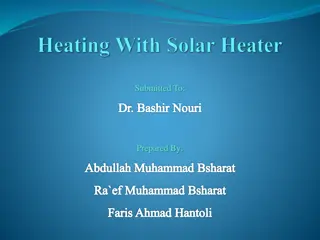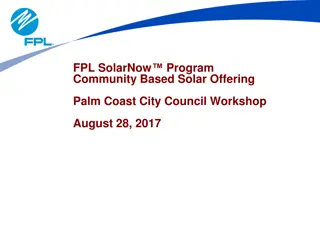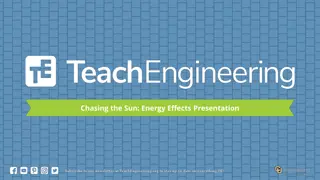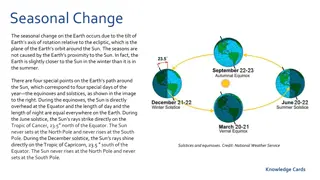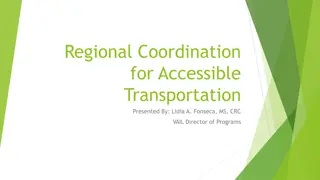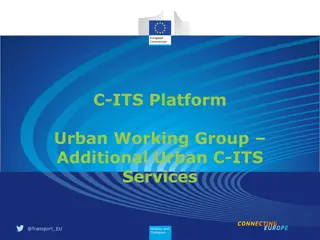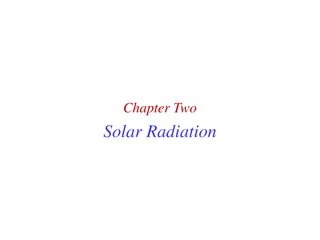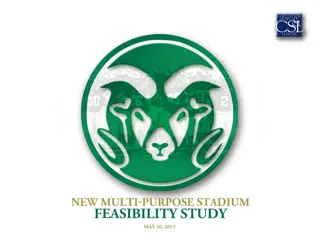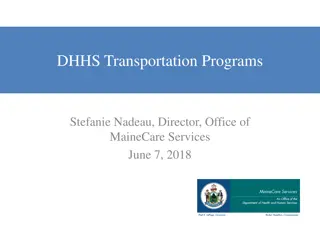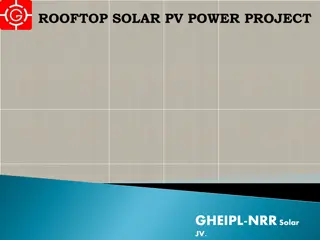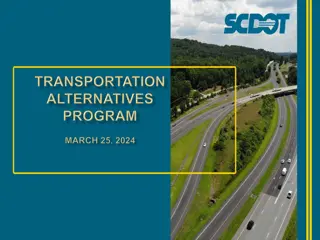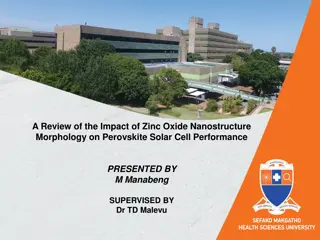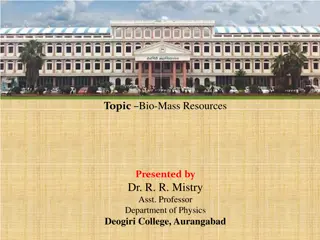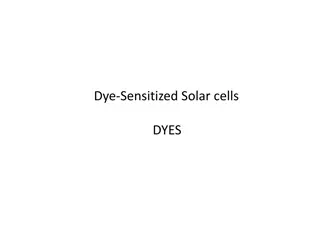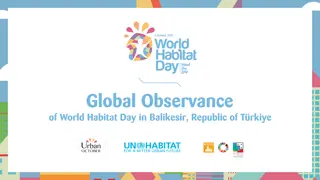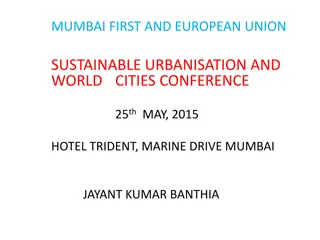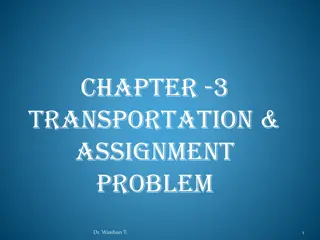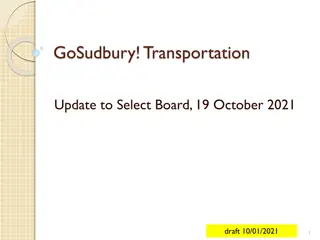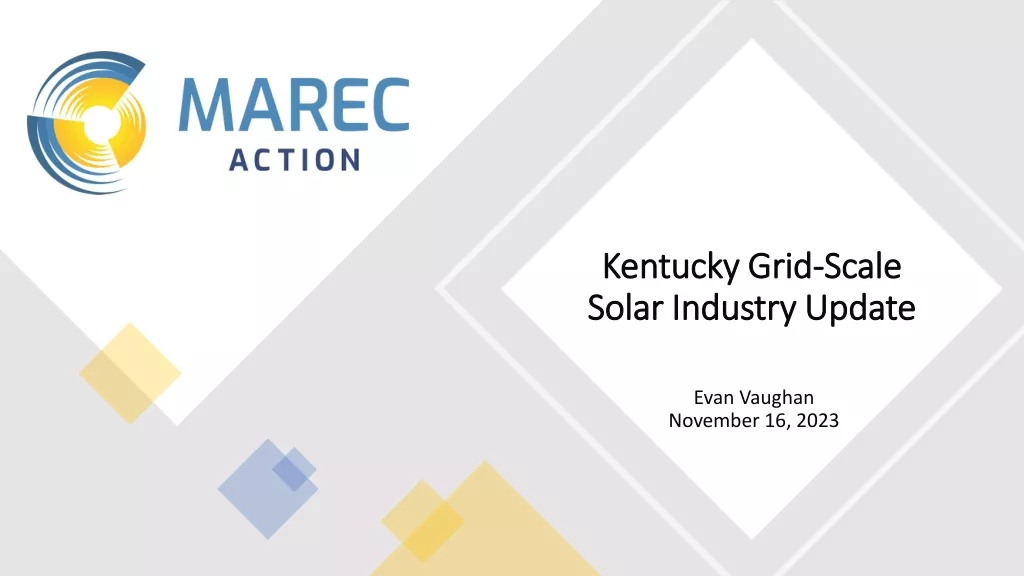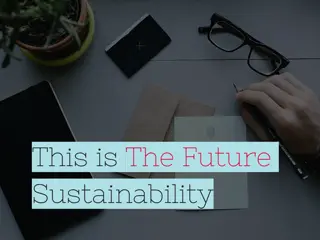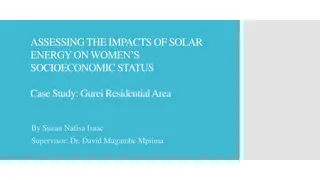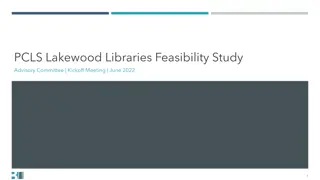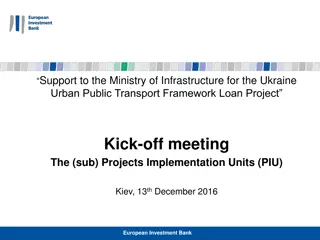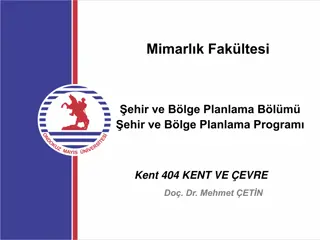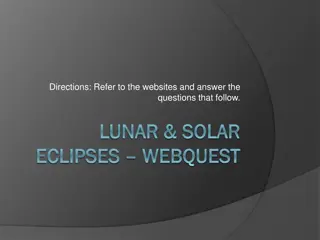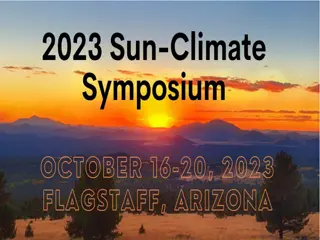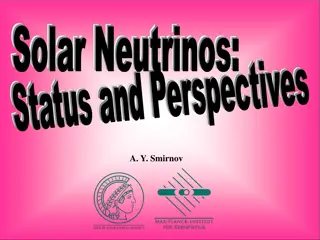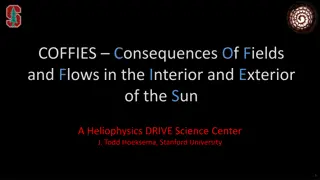Feasibility Study on Solar Energy in Tehran's Public Transportation for Urban Sustainability
Irregular energy consumption and urban challenges in transportation have led to a feasibility study on using solar energy in public transportation in Tehran. The study aims to determine the potential of solar energy for urban sustainability and address the importance of sustainable public transportation management to prevent future crises.
Download Presentation

Please find below an Image/Link to download the presentation.
The content on the website is provided AS IS for your information and personal use only. It may not be sold, licensed, or shared on other websites without obtaining consent from the author. Download presentation by click this link. If you encounter any issues during the download, it is possible that the publisher has removed the file from their server.
E N D
Presentation Transcript
FEASIBILITY STUDY FOR USING FROM SOLAR ENERGY IN PUBLIC TRANSPORTATION ALONG WITH THE URBAN SUSTAINABILITY (CASE STYDY: TEHRAN) Presented by: Soroush ARJOMANDZADEH THESIS SUPERVISOR: Maizia MINDJID Master in Planning and Sustainability: Urban & Regional Planning UNIVERSITY FRAN OIS RABELAIS OF TOURS POLYTECHNIC SCHOOL - PLANNING DEPARTMENT
PREFACE PROBLEM DEFINITION RESEARCH QUESTION RESEARCH AIMS LITERATURE RESEARCH METHODOLOGY HYPOTHESES CONCLUSION
Irregular energy consumption in most countries, world's attention to energy consumption improvement as well as environmental preservation have caused many countries to conduct research and studies for energy consumption improvement and replacement of oil products. This issue is developing and on the other hand, transportation especially in populous cities is known as the most urban challenge subject in last decades. PREFACE PROBLEM DEFINITION RESEARCH QUESTION RESEARCH AIMS LITERATURE RESEARCH METHODOLOGY HYPOTHESES CONCLUSION
PREFACE PROBLEM DEFINITION The fact is that, public transit is not rendered appropriately and it will turn into a crisis in the near future if no preventive or corrective measure is taken. That is why developed and developing countries have no option other than moving toward a sustainable public transportation management. RESEARCH QUESTION RESEARCH AIMS LITERATURE RESEARCH METHODOLOGY HYPOTHESES CONCLUSION
PREFACE PROBLEM DEFINITION The importance and necessity of conducting this kind of study will be defined with emphasis on three subjects that the present study has been conducted in order to answer these three Questions: RESEARCH QUESTION RESEARCH AIMS 1. To what extent, using from renewable energies with emphasis on the Solar Energy in the Urban Transportation Sector can lead to Urban Sustainability? LITERATURE RESEARCH 2. How and what are the potentials of Iran, with emphasis on the use from the Solar Energy for the Urban Applications? METHODOLOGY HYPOTHESES 3. Will use from the Solar Energy in the Urban Transportation, help to Sustainability of City of Tehran? CONCLUSION
PREFACE PROBLEM DEFINITION RESEARCH QUESTION RESEARCH AIMS The present study tries to answer this question: If using from the Solar Energy as a Renewable Source of Energy in the urban transportation system, can lead to sustainability of the City? LITERATURE RESEARCH METHODOLOGY HYPOTHESES CONCLUSION
TEHRAN AIR POLLUTION PREFACE PROBLEM DEFINITION RESEARCH QUESTION RESEARCH AIMS Air pollution derived from fossil fuels of the automotive in Iran, especially in metropolises or big cities like Tehran is under critic and dangerous conditions. Air pollution in Tehran has reached to a high amount in many cases which resulted in a dangerous status reported by environment official and healthcare managers and they warn seriously for not going out from home. For instance, during the recent years, elementary and secondary schools were closed for a few days for many times and the whole city organizations were also forced closure in emergency cases. LITERATURE RESEARCH METHODOLOGY HYPOTHESES CONCLUSION
BRT LINES IN TEHRAN PREFACE PROBLEM DEFINITION RESEARCH QUESTION RESEARCH AIMS LITERATURE RESEARCH METHODOLOGY HYPOTHESES Bus rapid transit system, is the beginning of changing of view and making big revolution in urban traffic and transportation management structure. According to studies, 10 main corridors of city are chosen for making rapid bus system and 6 lines are established, until now there is 164 KM bus special line in Tehran. CONCLUSION
BRT LINES IN TEHRAN PREFACE PROBLEM DEFINITION RESEARCH QUESTION RESEARCH AIMS LITERATURE RESEARCH METHODOLOGY HYPOTHESES But for safe and easy plying of public vehicles in Tehran, we need to 200KM special line. The putting into operation of these 6 lines of BRT by 1100 buses. CONCLUSION
SOLAR ENERGY IN IRAN PREFACE PROBLEM DEFINITION RESEARCH QUESTION RESEARCH AIMS LITERATURE RESEARCH Iran with about 300 sunny days per year is of the best countries of the world to produce potential solar energy, which is more than 6 times of European countries. Also, annual solar radiation in central areas of Iran is 7.7 h/day or 2800 h/year. Therefore, regarding this, the average solar radiation is about 5 kwh/days while the sequential cloudy days per year in our country are less than 5 days/year. METHODOLOGY HYPOTHESES CONCLUSION
Estimation of Technical Potential to Use Solar Panels in Tehran Public Transportation System PREFACE PROBLEM DEFINITION RESEARCH QUESTION RESEARCH AIMS LITERATURE RESEARCH METHODOLOGY Pointing out the experiences of other countries to apply solar power plants, BRT line of Tehran which is more than 60 KM can be covered by solar panels to generate electricity in the first step to decrease the pollutants from city buses fuels and decrease their noise and acoustic pollutions and a sustained environment and also to help public transportation system of Tehran. One of the experiences of the case is the green train of Amsterdam-Paris which has recently started to work. On this path, the 3.6 KM tunnel which passes from Antrope in the north of Belgium, has been covered with 16000 solar panels which is 50000 Sq. M area (about 5 football grounds). HYPOTHESES CONCLUSION
PREFACE PROBLEM DEFINITION RESEARCH QUESTION RESEARCH AIMS LITERATURE RESEARCH The mentioned assumptions could be analysed according to following algorithm. The Toster system Program could be run in Matlab software to calculate the data. Different scenarios will occur as the length of BRT line covered by solar panel or velocity change: METHODOLOG Y HYPOTHESES CONCLUSION
Comprehensive Data PREFACE PROBLEM DEFINITION Regarding to all information s and mentions not in this paper we can use follow supposes: RESEARCH QUESTION 1. The total length of BRT line bus in Tehran : 164 km 2. Normal width of BRT line bus : 8 m 3. The output power in the year for 1 m^2 solar panel : 140 kwh /year 4. The rate of electricity consumption for an electric bus : 66 kwh /100 km 5.Total number of diesel buses in Tehran : 3547 6. Total number of BRT buses in Tehran : 1100 7. BRT bus speed : between 20 ~ 50 km/h 8. The average of bus speed : 35 km/h 9. The time of moving buses per day : 15 h (6 am ~ 9pm) 10. Average moving distance per day for each bus : 500 km 11. Fuel consumption of buses: 0.3 Liter/ km RESEARCH AIMS LITERATURE RESEARCH METHODOLOGY HYPOTHESES CONCLUSION
PREFACE PROBLEM DEFINITION RESEARCH QUESTION RESEARCH AIMS LITERATURE RESEARCH METHODOLOGY HYPOTHESES CONCLUSION
PREFACE PROBLEM DEFINITION RESEARCH QUESTION RESEARCH AIMS LITERATURE RESEARCH METHODOLOGY HYPOTHESES CONCLUSION
PREFACE PROBLEM DEFINITION RESEARCH QUESTION RESEARCH AIMS LITERATURE RESEARCH METHODOLOGY HYPOTHESES Today: If all the BRT Buses are electrified, the energy consumption will be 1391198KW per year which is quite high. Hypotheses 2: If 124KMof BRT line is covered by solar panels all amount of electric energy needed by Buses will be supplied. CONCLUSION Hypotheses 1: As velocity rises while all other variants are kept constant, the energy consumption decreases but the transporting activities slow down which causes further problems in transforming passengers. Hypotheses 3: According to the diagram If total length of BRT line(164km) is covered with solar panels, all amount of electric energy needed by Buses will be supplied and considerable amount of generated electric power remains.
PREFACE PROBLEM DEFINITION RESEARCH QUESTION RESEARCH AIMS LITERATURE RESEARCH METHODOLOGY HYPOTHESES Hypotheses 6: As the total bus line's length accomplished to 200km, if the total length is covered by solar panels, 1400 buses can be run with velocity of 45km/hr. Hypotheses 4: If half width of BRT line (4m) is covered by solar panels, a considerable amount of electric energy needed by Buses will be supplied. Hypotheses 5: If total length of BRT line (164km) is covered by solar panels, it is possible to add 50 buses to current number of buses (1150buses) and raise the velocity up to 45 Km/hr. CONCLUSION Hypotheses 7: If the buses and solar panel will be optimized efficiently in the future it can be possible to have 1450 buses with velocity of 50km/hr and remained significant extra generated electric power.
Estimation of Reduction of Air Pollution by using Solar Panel in Public Transportation in Tehran PREFACE PROBLEM DEFINITION Title Unit Definition R= 1- (P solar/ P diesel) [%] Reduction of chemical pollution in public transportation RESEARCH QUESTION gr diesel pollution variable P diesel= V diesel. D RESEARCH AIMS Gr/km Substances Pollution Emissions V diesel km Distance D LITERATURE RESEARCH gr Pollution variable after adding solar panel P solar= P diesel(T - T) / P diesel - Total number of diesel Buses T METHODOLOGY - Number of Electric Buses T HYPOTHESES gr NO x = (NO+NO2+NO3) Nitrogen oxides NO x CONCLUSION gr Carbon monoxide CO
Emissions for Diesel bus: PREFACE Co = 3.1 gr V Co diesel =3.1 gr/km PROBLEM DEFINITION Nox = 12.4 gr P= V. D D = 1 km V Nox diesel = 12.4 gr/km RESEARCH QUESTION P Co diesel = 3.1 gr/km, P Nox diesel = 12.4 gr/km The Emission of Carbon Monoxide for each Bus: 500 * 3.1 =1550 gr/day The Emission of Nitrogen Oxides for each Bus: 500 * 12.4= 6200 gr/day RESEARCH AIMS LITERATURE RESEARCH As a bus travel 500 kilometre, 1.7 ton Co and 6.8 ton Nox emitted to the air. METHODOLOGY R Co = 1 - (P Co solar/ P Co diesel)*100 R Co =1- (2447 * 3.1/ 3547 * 3.1) * 100 = = %31 Reduction of Diesel bus: HYPOTHESES CONCLUSION R Nox = 1 - (P Nox solar/ P Nox diesel)*100 R Nox = 1 - (2447 * 12.4 / 3547 * 12.4) * 100 =%31
All mentioned above leads us to the conclusion that using solar panels in BRT lines reduces the annual fuel consumption of 60 million litters. As a result the two air pollutant indexes of Co and Nox will be decreased as 2000ton and 8000 ton respectively. It is a significant step for changing consumption pattern and using recycled energy instead of fossil fuel. PREFACE PROBLEM DEFINITION According to what is said, the important un sustainability measures for the environment are energy consumption, Air pollution, and destruction of the natural resources. RESEARCH QUESTION Totally, it can be said that sustainability factor for the transportation, includes the reduction of energy consumption, reduction of the environment destruction, increase in the social sustainability for access to the transportation system as well as improvement in the efficiency and performance along with the economic development. RESEARCH AIMS LITERATURE RESEARCH Also with regard to the three defined levels about the sustainable transportation, namely environmental, social and economic levels, the present study emphasizes on the environmental dimension in order to reduce the pollutions resulted from the transportation sector by using from the renewable energies especially the solar energy. METHODOLOGY HYPOTHESES With regard to the special situation of Iran and specially Tehran City in terms of its complexities, the challenges faced by the urban management and transportation sector and also proper use from the radiation of the Sun in this region, the emphasis of the present study is placed on the use from the Solar Energy as a proper pattern of the Renewable Energies in the Sustainable Urban Transportation. All these can make the dream of having clean air come true and provide people with sustainable metropolises. CONCLUSION


